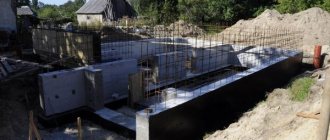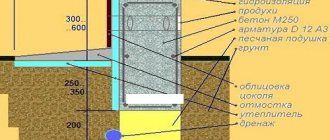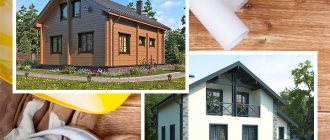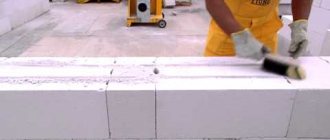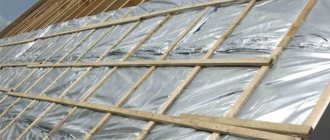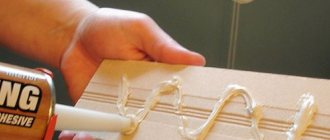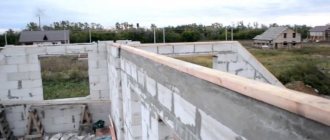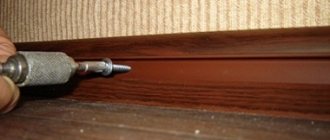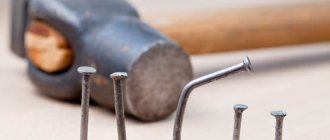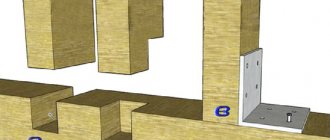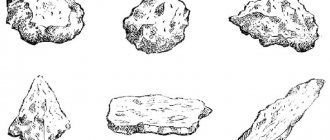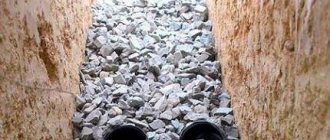New thermal insulation materials are appearing on the market with increased thermal protection and unique qualities. Such a material is penofol.
The use of penofol insulation allows you to achieve serious results due to its reflective and insulating qualities.
Penofol insulation is an excellent way of thermal insulation.
Advantages and disadvantages of penofol
The advantages of insulation include the following qualities:
- Environmental friendliness . Polyethylene and foil from which penofol is made are used for storing food, so the toxicity of the material is reduced to almost zero. According to some reports, it even protects against radiation.
- The material is very thin compared to its analogues, but is not inferior to them in quality. A layer of penofol 4 mm thick with double-sided foil can replace 8-8.5 cm of mineral wool, 3 cm of extruded polystyrene foam or 1.8 cm of wood (pine).
- The use of penofol will not require additional vapor barrier due to the low vapor permeability of the material. For him, it does not matter what the humidity is indoors or outdoors, and the time of year does not matter, since the insulation does not absorb moisture.
- Excellent sound insulation. Installing penofol on top of the frame of a building structure allows you to protect yourself from both acoustic and structural noise.
- Easy to install , does not break or crumble, does not require special tools or special clothing. It is easy to cut with a knife and fastened with small nails, tape or a furniture stapler.
- Fire safety . Insulation belongs to the class of low-flammability and low-combustibility materials.
- Convenient to transport. Thanks to its thin layer, the insulation is easily rolled into compact rolls and can be transported in the trunk of a car.
- Difficult to reach for rodents , which can easily live in another (thicker) insulation.
- Penofol is certified and has a conclusion from the sanitary-epidemiological authority.
Like any insulation material, penofol has its own disadvantages . What are they?
- Softness . Polyethylene does not have sufficient rigidity, so penofol is not suitable for finishing with plaster or wallpaper. Just apply a little pressure and the material will bend.
- The insulation is difficult to attach, with the exception of type C penofol (with self-adhesive film). For installation it is necessary to use special adhesives. It is not advisable to nail it to the surface, since this will deteriorate the thermal insulation properties of the material.
- No matter how wonderful penofol is, when insulating the external walls of buildings it is often used as an additional layer , which will, first of all, reflect thermal energy and protect the walls from moisture.
Insulation materials
107 votes
+
Vote for!
—
Vote against!
A multifunctional material is presented on the construction market - Penofol, which, with a minimum thickness, provides almost 100% results. It is used for heat and sound insulation of buildings of any type. It can act as an additional or independent layer.
- Insulation of walls with Penofol from inside the room
Insulation Penofol
The range of Penofol allows its use in individual houses, civil buildings and industrial buildings:
- insulation of walls, floors, ceilings, attics and attics;
- insulation of pipes in water supply and heating systems;
- insulation of equipment in various industries, including agricultural, medical and food production;
- ventilation and air conditioning systems;
- insulation of various types of installations used for transporting cold and hot food products;
- rooms with high temperature conditions (drying chambers, baths, saunas, etc.);
- heat and sound insulation of passenger and truck bodies;
- This universal material is widely used in underfloor heating systems.
Penofol photo
Foiled Penofol insulation
The combined material consists of a base layer, that is, porous polyethylene with one or two-sided coating of a metal sheet (foil). Its uniqueness lies in the simultaneous performance of several functions: convection and heat reflection. Thus, with a small thickness of Penofol, it is possible to achieve amazing heat and sound insulation. The material is produced in rolls. Sheets can have a thickness from 3 to 10 mm.
The comparative table presents different types of building materials, the use of which can achieve the same result. Penofol type B 4 mm thick is equivalent to:
| Name | Thickness (mm) |
| Brick | 672 |
| Sand-lime brick | 840 |
| Gas foam concrete | 348 |
| Mineral wool | 67 |
| Expanded polystyrene | 46 |
Advantages
- Ecological cleanliness. The raw materials for production are polyethylene and foil, which have been successfully used in the food and medical industries for many decades.
- A thin layer of material guarantees high thermal resistance. A sheet of Penofol 4 mm thick is equivalent to wall masonry of 2.5 bricks;
- High vapor permeability ensures free release of excess moisture. The absorbency of the material is zero, so its use is possible in rooms with high humidity levels. Foiled polyethylene foam is also used for outdoor work.
- The material is characterized by excellent sound insulation properties. It will protect the structure from acoustic and structural noise.
- The light weight of the sheets ensures quick installation. Thanks to its elasticity, the material fits perfectly on any surface. Lining can be done with an ordinary kitchen knife. Fastening is carried out using self-adhesive aluminum tapes and a furniture stapler.
- Non-flammability. Fire technical characteristics state that the presented material belongs to the low-flammable and low-flammability groups (G1 and, accordingly, B1). With prolonged exposure to open fire, the sheets may smolder slightly (smoke-forming ability D2).
- Convenient for storage and transportation. Lightweight and flexible canvases are rolled into compact rolls that fit even in the trunk of a car.
Flaws
- The softness of foamed polyethylene has a beneficial effect during installation, but negatively affects the further finishing of the building or room. The surface is not intended for plastering or wallpapering.
- Despite the high physical and technical characteristics of the material, it is used in most cases as an additional layer. To achieve effective thermal insulation results, it is recommended to use it in combination with other types of insulation.
Penofol video
Penofol application
The manufacturer presents several modifications, the letter designation of which informs about its features.
| type | Thickness (mm) | Length (mm) | Width (mm) | characteristics | scope of application |
| A | 3,4,5, 8 and 10 | With a thickness of up to 5 mm – 3000 mm; 8 and 10 mm – 1500 mm | 1200 | foamed polyethylene with one foil side | It is mainly used for insulating walls, attics and attics together with other types of insulation. This material is widely used for insulation of engineering systems |
| IN | 3,4,5, 8 and 10 | With a thickness of up to 5 mm – 3000 mm; 8 and 10 mm – 1500 mm | 1200 | Foamed polyethylene base with double-sided foil | Effective as an independent insulation for interfloor ceilings and internal walls, partitions |
| WITH | 3,4,5, 8 and 10 | 600 | One side of the polyethylene foam is covered with aluminum foil, the other with a self-adhesive layer. Installation is carried out without the use of additional fasteners | Used for insulating complex structures, optimal for hard-to-reach places | |
| ALP | 3 | 3000 mm | 600 | The base is covered with foil on one side. The foil side is laminated with polyethylene film | This product provides reliable protection against corrosion processes. Ideal for use in underfloor heating systems |
Today, products are also produced in other modifications, for example, with a reinforced base (fiberglass) or additional perforation, which are intended for external insulation of building structures.
How to insulate with Penofol
- Mounting the canvases is quite simple; fastening to the surface is done using staplers or adhesives. The sheets are placed end-to-end, but overlaps of up to 10 cm are allowed. The foil side should face the inside of the room, house, pipe, etc.
- Particular attention should be paid to insulating the wiring, since aluminum is a good conductor of electricity. Plastic channels or corrugated pipes can be used here.
- The basic rule that must be observed is the presence of a ventilation gap of 1.5-2 cm on both sides of the material. This is explained by the fact that the polyethylene base is absolutely waterproof, so the moisture that inevitably arises during the operation of the structure will accumulate and moisten other structural elements.
- Assembly joints or accidental cuts in the panels are glued with self-adhesive aluminum tape (LAS or LAMS). Mounting tape ensures complete vapor and waterproofing of the system.
Insulation of walls with Penofol from inside the room
Internal wall insulation will prevent the formation of moisture, and therefore the development of mold and mildew. The work is carried out in the following order.
- Slats 1.5-2 cm thick are attached to the surface in a vertical position; this characteristic will provide the required ventilation gap. The pitch between the bars should be 600 mm. Since the width of the canvas is 1200 mm, this indicator is optimal for installing insulation.
- Laying is done with the foil side facing the inside of the room. The edges should be located in the middle of the slats. The next sheet is placed end to end with the previous one. The optimal fastener is a construction or furniture stapler; you can use small nails.
- Cutting the canvas to length is carried out using a ruler and a sharp knife or blade.
- All connecting seams are taped with special tape, which will ensure complete sealing between the canvases.
- The next step is to re-install the slats. Their location is selected depending on the characteristics of subsequent finishing materials. A wooden frame can serve as a basis for attaching panels made of plastic or wood, as well as plasterboard sheets, which are puttied and then painted or wallpapered.
Installation of Penofol outside the building
Experts say that the most effective way of insulation is to install heat-insulating material outside. The perforated modification of Penofol facilitates the free removal of steam and moisture emanating from the building. In addition, the material protects the walls from wind and precipitation and provides a high level of sound insulation. An important advantage of external installation of insulation is saving the usable space of the room.
- Insulation is recommended to be carried out in dry, warm weather. The surface is cleaned of previous coatings, dust and dirt. Then it is subjected to antiseptic treatment. Particular attention should be paid to the corners and lower parts of the walls, as they are more susceptible to freezing.
- As with internal insulation, slats are mounted on the surface. Fasteners are selected depending on the wall material.
- The canvases are laid end to end. Fastening is carried out with a stapler. The seams between the sheets, as well as the junction of their upper and lower parts to the walls, are taped with aluminum mounting tape.
- Next, the outer frame is built, which is lined with profiled sheets, vinyl siding and other materials. If the cladding is brick, then there is no need for a re-frame. In this case, the masonry is erected at a distance of 30-40 mm from the load-bearing walls, ensuring the necessary connection, taking into account the features and nature of the structure being built.
Insulation of cement floor with Penofol
- Material grade A can be used as a substrate for parquet, laminate, linoleum. It will show high performance in terms of heat and waterproofing, as well as noise absorption.
- To insulate concrete floors, first screed with a mortar with the addition of expanded clay. However, dirty and labor-intensive work can be avoided if this layer is replaced with sheets of foam plastic 5-10 cm thick, on top of which the sheets are laid with the foil side up.
- The edges should extend 10 cm onto all walls. The canvases themselves are laid without overlap. The connecting seams are taped with aluminum tape.
- To provide a ventilation gap between the insulation and the finishing material, slats or logs are packed. Wooden elements are treated with antiseptics to prevent premature rotting.
- Make an indent of 1-2 cm from the wall and install slats along the entire length of the room in increments of 40 cm. The horizontalness is checked with a building level or laser, and if necessary, adjustments are made by placing wood chips.
- The edges of the insulation interfering with the walls are carefully cut off.
- Sheets of plywood (12 mm), fiberboard or chipboard are laid on top of the frame. Self-tapping screws are screwed in every 15-20 cm. The subfloor is covered with any facing material.
Installation of Penofol in the "Warm Floor" system
- The presented material provides not only hydro- and sound insulation, but also guarantees excellent heat transfer due to the reflective foil layer.
- Canvases of grade A or C are spread with foil on top of the base, end-to-end, with an obligatory edge on the walls (10 cm each). The joints of the material and accidental cuts are taped with mounting tape (LAMS).
- Next, the heating elements are laid. Between them, bars are laid, which will serve as the basis for laying parquet, laminate or other piece products.
- In the case when the heating system is filled with sand-cement screed (under ceramic tiles), a modification of Penofol - ALP - is used. This type of material does not react to unfavorable environments.
- Laying is done with a spade on the walls and butt joints, the seams must be taped.
- After installing the heating elements, the system's functionality is checked. Then the reinforcing mesh is lined and the concrete solution is poured. When the screed is dry, the protruding edges of the Penofol are cut off.
The physical and technical characteristics of this material make it possible to use it for insulation and simultaneous protection from cold, dampness and noise. At the same time, the small thickness of Penofol allows rational use of the internal and external space of buildings and other structures without loss of functional properties.
Types of penofol
There are several varieties of penofol, each of which is represented by a specific brand. The letter marking of insulation informs about its main characteristics and differences. So, types of penofol:
- Type A - has an aluminum coating on one side only. It is usually used in conjunction with other insulation materials, for example, polystyrene foam or styrodur.
- Type B - coated with aluminum on both sides. Suitable for standalone use.
- Type C (self-adhesive) - has an aluminum layer on one side, and polyethylene foam with moisture-resistant contact adhesive applied to it on the other. Can be used without the use of additional installation tools.
- Type ALP - a polyethylene film is welded onto the aluminum surface of one side, due to which penofol of this type is called laminated. Suitable for use in agriculture and mildly aggressive environments.
- Types R and M - embossed penofol with one-sided foil.
- Super NET comes from the English “network”, respectively, the main purpose of such penofol is to insulate networks (pipelines, heating mains, air vents).
- Penofol AIR is used for the manufacture of special air exhaust structures.
Penofol 2000 is found on sale It means that the insulation is a cheap version of regular penofol , while being inferior to it in strength.
The letters representing the markings may vary from each other. Deciphering will not be difficult if you know the above designations of material types.
Which Penofol to choose?
Polyethylene foam is produced in the form of three main types of sheets, which differ in manufacturing technology, technical characteristics and dimensions.
- Type A is a polymer of varying thickness, with foil applied on one side. Suitable for complex insulation of building structures. To enhance the effect, it can be combined with other insulation materials (glass wool, mineral wool).
- Type B is distinguished by the fact that polyethylene is covered with foil on both sides, and this allows you to achieve maximum insulating effect. Ideal for insulating load-bearing structures of attics, floors and walls, and basements. Often used for thermal insulation of roofs.
- Type C is self-adhesive Penofol. On the one hand, polyethylene has a layer of foil, and on the other, industrially applied adhesive covered with a thin film. This ensures ease of installation and time savings.
Application of penofol
In construction, penofol is used as a middle layer of thermal insulation or as an independent insulation in the following types of work :
- internal and external insulation of walls of buildings, attics, basements, attics;
- water, steam and thermal insulation of baths, saunas, showers;
- insulation of roof and heated floors;
- insulation of expansion tanks and pipelines;
- heat reflection from home radiators;
- sound insulation and insulation of ventilation, air conditioning and sewage systems.
How to attach penofol to the wall
How to attach penofol to the wall with your own hands
The content of the article
Today, such a multifunctional building material as penofol is increasingly being chosen to protect and insulate the surfaces of walls and floors.
Having a slight thickness and a heat-reflecting surface, penofol can provide good results in preventing heat loss at home.
You should know that penofol can provide the maximum possible effect in insulation together with other thermal insulation materials. So, what penofol is and how it is installed on walls or to the surface of other insulation will be discussed in this article.
Where is penofol used?
Penofol is widely used both for insulation of private houses and for thermal insulation of industrial facilities. Having high thermal insulation properties and a very small thickness, penofol is able to completely replace insulation materials such as polystyrene foam and mineral wool (though not everywhere).
Penofol has received the widest use:
- When insulating the internal walls of a house, ceilings and floors;
- Thermal insulation of pipelines, as well as individual elements of heating and plumbing systems;
- For insulation of ventilation, air conditioning systems, etc.
The use of penofol is very popular in the automotive industry, as well as where it is necessary to reduce large heat losses. In addition, penofol is used to decorate the surfaces of baths and saunas, as well as drying and freezing chambers.
Simple installation and ease of use make penofol simply an indispensable building material. As an example, we can cite the installation of heated floors in an apartment where it is not possible to use special mats for heated floors or foam sheets due to their large thickness.
How to attach penofol to the wall
Insulating walls with penofol is quite simple. For these purposes, depending on what building material they are made of, you can use metal staples or special glue.
When insulating, penofol sheets are fixed to the wall surface end-to-end, and in some cases, on the contrary, with a slight overlap on each other. To prevent heat loss, the foil part of the penofol must always face the inside of the insulated room.
Also, to prevent heat from escaping through the joints between the penofol, they should definitely be covered with metallized tape or, in extreme cases, regular tape. Penofol should be attached to the wall, observing another important rule.
It is recommended that a small gap of 1-2 cm be maintained on both the outer and inner sides of this material. The gap between the penofol and the insulated surface is needed in order to avoid the accumulation of moisture between them.
Rate this article and share the link:
samastroyka.ru
Technology for insulating walls from the inside
Steam entering building structures from outside leads to the formation of mold and mildew on the inner surface of the walls. This problem is solved by insulating the walls from the inside with penofol, which allows the walls to “breathe” and not accumulate moisture.
Penofol type A, B or C is selected for the work. It all depends on the characteristics of the thermal insulation and the planned installation method. Penofol, A is attached to massive insulation for waterproofing purposes, type B is used autonomously, type C is mounted on the base of the wall.
The work is carried out in the following order:
- Before installation begins, a frame is made from wooden slats (1.5-2 cm) on the wall, providing 20 mm of free air space on both sides of the foam foam. This is necessary for maximum effect from the use of insulation. The bars are fastened with dowels at a distance of no more than 100 cm from each other.
- A mandatory step before starting work on laying penofol will be checking the quality of the electrical wiring and, if necessary, carrying out additional insulation. Aluminum has high electrical conductivity, due to which contact of penofol with bare wires is unacceptable.
- Penofol is attached to the frame using a furniture stapler. The strips are cut with a knife and placed end-to-end, the seams are taped with aluminum tape. It is not recommended to make an overlap fastening , as this leads to condensation flowing along the overlap line in the event of steam formation.
- Next, the wooden frame is re-installed ( don’t forget about the 2 cm air “corridor”). It can be covered with any sheets, slabs or panels that are puttied, painted or wallpapered.
Installation
Wall treatment from the inside
Wall insulation with penofol is done using self-tapping screws or a stapler.
For interior work, one-sided penofol with a thickness of 4–5 mm is used. You can also use double-sided, but its installation is different, since it is necessary to maintain an air gap on both sides. In ordinary apartments and houses, one-sided material is sufficient, but if the walls are too cold, then they should be additionally insulated with polystyrene foam or cotton wool.
Our instructions will help you understand how to insulate a wall with penofol from the inside:
- We roll out the roll of insulation and cut off a strip equal in length to the length of the wall;
Cut the strip to the required length.
- Starting from the ceiling, we nail the strip to the wall with a stapler;
Carefully attach the insulation strip.
- If the wall is wooden, you can also use a screwdriver. We put large washers on the screws, like on umbrella-type dowels;
We put washers on the screws.
- If the wall is concrete and it is impossible to nail the material to it with staples or screws, use glue;
- We cover the entire wall with penofol end-to-end, without making any overlaps;
We cover all walls without overlaps.
- We glue the joints with aluminum adhesive tape;
We glue the joints with aluminum tape.
- On top of the insulation we place a lathing made of slats or plywood with a thickness of at least 1.5 - 2 cm;
We fill the crate on top.
- We install plasterboard, chipboard or other sheathing on the sheathing.
We stuff the casing on top.
Important! On the side of the foil coating, be sure to leave an air gap 1.5–2 cm thick, otherwise condensation will accumulate on the surface. If the material is double-sided, the gap must be maintained on both sides.
Ceiling and floor
Insulating the ceiling with penofol significantly increases the energy efficiency of the room.
Installation of material on the ceiling is not fundamentally different from similar work on walls.
First, the material is cut, the desired strip is taken and attached along the wall, starting from the middle:
We mount the strip from the middle along the wall into the corner.
We reach one corner, nailing the side closest to the wall:
We fasten one side.
Then from the middle we move in the opposite direction, attaching the strip further:
One side of the strip is nailed.
Next, from the middle point we move perpendicular to the foam sheet and shoot at the line indicated in the photo in green:
We nail the middle line.
Next, we move from the middle to the corners, smoothing and shooting the material towards the ceiling:
We finally fasten the strip.
Similarly, you can insulate the floor with penofol or insulate the loggia. The main thing to remember is the basic rule: leave a gap between the casing and the foil!
Advice! In the case of a loggia, penofol should be used together with expanded polystyrene, since the balcony structures are too thin for serious thermal insulation.
During floor insulation work, the material is placed with the foil facing up. We glue the insulation to the screed or floor slab with any glue suitable for such substances. Then we lay logs on the carpet, on which we mount floorboards or plywood.
When using double-sided material, it is usually placed in the joist space so that there is an air gap on both sides. To do this, you can nail the carpet to the joists in the middle of the distance from the floor to the upper plane, then throw the material over the slats, and fasten it on the other side as well.
Then the insulation is stretched in the middle of the space, between the floor and the boards.
In addition, do not forget to attach the strips end-to-end, and treat the joints with aluminum tape. The material is soft and pliable, making it easy to cover curved and curved areas of walls. The low weight of the coating does not create any noticeable additional load on the structure.
How to insulate a wall from the outside with penofol
External insulation of the walls of a house, especially a wooden one, according to experts, is more effective than internal thermal insulation.
For this type of insulation, perforated penofol is used, which, in addition to sound and heat insulation, protects the building from wind and precipitation and promotes the release of steam from the structure.
External insulation is suitable in a situation where you do not want to change the interior environment or reduce the usable area of your home due to thick layers of heat insulation . The insulation is installed between the wall of the house and the cladding.
It is very important to carry out external insulation of a house in the warm season, when temperature changes are minimal and the walls of the building are completely dry.
